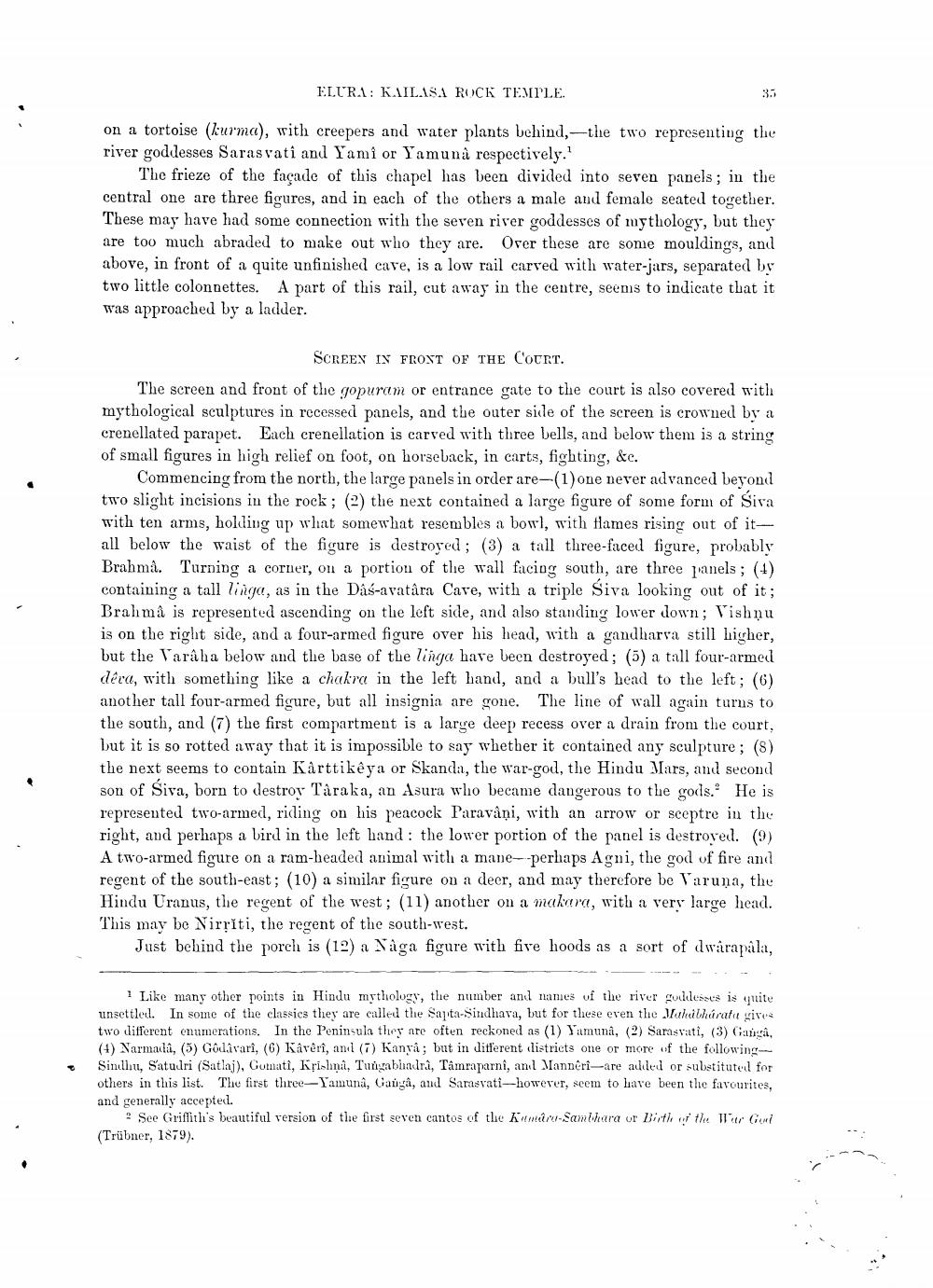________________
ELURA: KAILASA ROCK TEMPLE.
on a tortoise (kurma), with creepers and water plants behind, -the two representing the river goddesses Sarasvati and Yami or Yamuna respectively."
35
The frieze of the façade of this chapel has been divided into seven panels; in the central one are three figures, and in each of the others a male and female seated together. These may have had some connection with the seven river goddesses of mythology, but they are too much abraded to make out who they are. Over these are some mouldings, and above, in front of a quite unfinished cave, is a low rail carved with water-jars, separated by two little colonnettes. A part of this rail, cut away in the centre, seems to indicate that it was approached by a ladder.
SCREEN IN FRONT OF THE COURT.
The screen and front of the gopuram or entrance gate to the court is also covered with mythological sculptures in recessed panels, and the outer side of the screen is crowned by a crenellated parapet. Each crenellation is carved with three bells, and below them is a string of small figures in high relief on foot, on horseback, in carts, fighting, &c.
Commencing from the north, the large panels in order are-(1)one never advanced beyond two slight incisions in the rock; (2) the next contained a large figure of some form of Śiva with ten arms, holding up what somewhat resembles a bowl, with flames rising out of itall below the waist of the figure is destroyed; (3) a tall three-faced figure, probably Brahmâ. Turning a corner, on a portion of the wall facing south, are three panels; (4) containing a tall linga, as in the Dâs-avatâra Cave, with a triple Śiva looking out of it; Brahma is represented ascending on the left side, and also standing lower down; Vishnu is on the right side, and a four-armed figure over his head, with a gandharva still higher, but the Varaha below and the base of the linga have been destroyed; (5) a tall four-armed deva, with something like a chakra in the left hand, and a bull's head to the left; (6) another tall four-armed figure, but all insignia are gone. The line of wall again turns to the south, and (7) the first compartment is a large deep recess over a drain from the court, but it is so rotted away that it is impossible to say whether it contained any sculpture; (8) the next seems to contain Kärttikêya or Skanda, the war-god, the Hindu Mars, and second son of Siva, born to destroy Taraka, an Asura who became dangerous to the gods." He is represented two-armed, riding on his peacock Paraváni, with an arrow or sceptre in the right, and perhaps a bird in the left hand: the lower portion of the panel is destroyed. (9) A two-armed figure on a ram-headed animal with a mane-perhaps Agni, the god of fire and regent of the south-east; (10) a similar figure on a deer, and may therefore be Varuna, the Hindu Uranus, the regent of the west; (11) another on a makere, with a very large head. This may be Nirriti, the regent of the south-west.
Just behind the porch is (12) a Naga figure with five hoods as a sort of dwarapala,
1 Like many other points in Hindu mythology, the number and names of the river goddesses is quite unsettled. In some of the classics they are called the Sapta-Sindhava, but for these even the Mahabharata gives two different enumerations. In the Peninsula they are often reckoned as (1) Yamuna, (2) Sarasvati, (3) Ganga, (4) Narmada, (5) Godavari, (6) Kâvêrî, and (7) Kanya; but in different districts one or more of the followingSindhu, Satudri (Satlaj), Gomati, Krishna, Tungabindra, Tâmraparni, and Mannêri-are added or substituted for others in this list. The first three-Yamuna, Ganga, and Sarasvati-however, seem to have been the favourites, and generally accepted.
2 See Griffith's beautiful version of the first seven cantos of the Kamaru-Sambhara or Birth of the War God (Trübner, 1879).




